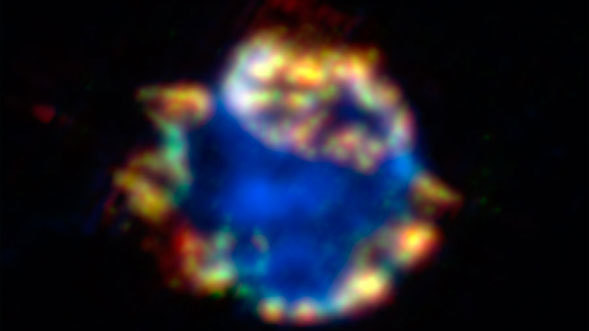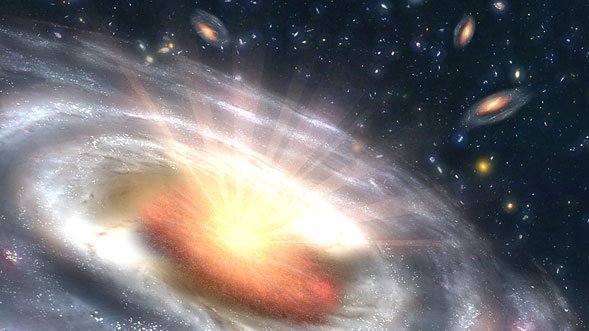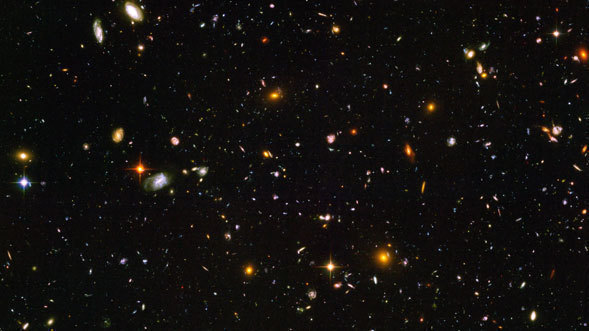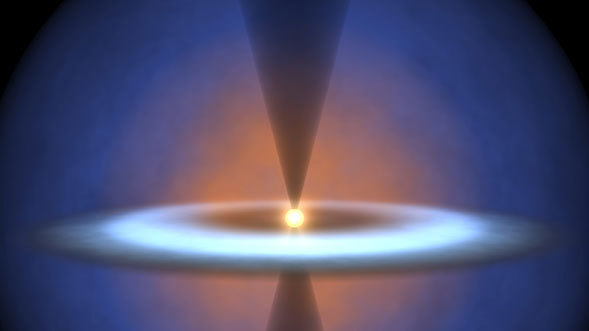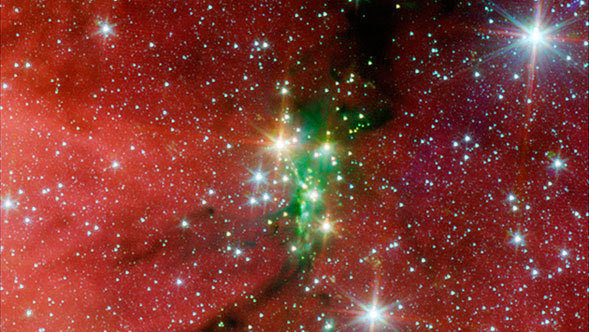Displaying news 331 - 360 of 516 in total
New observations from NASA's Spitzer Space Telescope suggest that galaxies prefer to raise stars in cosmic suburbia rather than in "big cities."
At a ceremony held today at the National Federation of the Blind, NASA unveiled a new book that brings majestic images taken by its Great Observatories to the fingertips of the blind.
NASA's Spitzer Space Telescope has detected plump black holes where least expected -- skinny galaxies.
It's official -- "The Hidden Universe" is no longer a secret. The video podcast series from NASA's Spitzer Space Telescope Science Center has reached one million downloads!
Astronomers have at last found definitive evidence that the universe's first dust -- the celestial stuff that seeded future generations of stars and planets -- was forged in the explosions of massive stars.
Billions of years ago, small galaxies across the universe regularly collided -- forcing the gas, dust, stars, and black holes within them to unite. The clashing of galactic gases was so powerful it ignited star formation, while fusing central black holes developed an insatiable appetite for gas and dust.
M51, whose name comes from being the 51st entry in Charles Messier's catalog, is considered to be one of the classic examples of a spiral galaxy. At a distance of about 30 million light years from Earth, it is also one of the brightest spirals in the night sky. A composite image of M51, also known as the Whirlpool Galaxy, shows the majesty of its structure in a dramatic new way through several of NASA's orbiting observatories. X-ray data from NASA's Chandra X-ray Observatory reveals point-like sources (purple) that are black holes and neutron stars in binary star systems. Chandra also detects a diffuse glow of hot gas that permeates the space between the stars. Optical data from the Hubble Space Telescope (green) and infrared emission from the Spitzer Space Telescope (red) both highlight long lanes in the spiral arms that consist of stars and gas laced with dust. A view of M51 with the GALEX telescope shows hot, young stars that produce lots of ultraviolet energy (blue).
A developing star wrapped in a black cocoon of dust is seen sprouting giant jets in a new image from NASA's Spitzer Space Telescope.
A stellar prodigy has been spotted about 450 light-years away in a system called UX Tau A by NASA's Spitzer Space Telescope. Astronomers suspect this system's central Sun-like star, which is just one million years old, may already be surrounded by young planets. Scientists hope the finding will provide insight into when planets began to form in our own solar system.
The next time you take a moonlit stroll, or admire a full, bright-white moon looming in the night sky, you might count yourself lucky. New observations from NASA's Spitzer Space Telescope suggest that moons like Earth's -- that formed out of tremendous collisions -- are uncommon in the universe, arising at most in only 5 to 10 percent of planetary systems.
Dr. David Charbonneau was named Discover Magazine's "Scientist of the Year" for his work in detecting and characterizing planets around nearby Sun-like stars. His profile appears in the December issue, which hits newsstands on November 13, 2007.
A new image from NASA's Spitzer Space Telescope shows a baby star 1,140 light-years away from Earth blowing two massive "bubbles." But instead of bubble gum, this youngster, called HH 46/47, is using powerful jets of gas to make bubbles in outer space.
Astronomers have unmasked hundreds of black holes hiding deep inside dusty galaxies billions of light-years away.
On Earth, thieves steal everything from diamonds to art to bags full of money. In space, gas -- fuel for making stars -- is a commodity worth the price of theft.
Dusty infrared galaxies are cosmic "nurseries" for some of the universe's hottest young stars -- and new research from NASA's Spitzer Space Telescope shows that when the universe was approximately six billion years old, these galaxies packed into the densest "zip codes" in space. Astronomers hope that this latest finding will give them insights into why the modern universe looks the way it does.
The hit song that proclaimed, "All we are is dust in the wind," may have some cosmic truth to it. New findings from NASA's Spitzer Space Telescope suggest that space dust -- the same stuff that makes up living creatures and planets -- was manufactured in large quantities in the winds of black holes that populated our early universe.
An Earth-like planet is likely forming 424 light-years away in a star system called HD 113766, say astronomers using NASA's Spitzer Space Telescope.
The National Women's Hall of Fame has selected Dr. Judith Pipher, a Spitzer Space Telescope astronomer, to join its ranks. Pipher is one of nine women to be inducted during a weekend of ceremonies October 6-7, 2007.
View the world through heat-sensitive infrared eyes at SkInfrared, a free art exhibit presented by NASA's Spitzer Space Telescope science center at the One Colorado Courtyard in Old Pasadena, Calif. -- from October 10 to 31, 2007. This exhibit is held in conjunction with Pasadena's Skin/Art & Ideas 2007 festival.
On Earth, neon signs point to motel vacancies and nearby eateries. Now for the first time, astronomers have spotted neon gas in disks around stars -- and they're hoping the glowing gas will point the way to new discoveries about how planets rise from the materials that swirl around young stars.
NASA's Hubble and Spitzer Space Telescopes have joined forces to discover nine of the smallest, faintest, most compact galaxies ever observed in the distant Universe. Blazing with the brilliance of millions of stars, each of the newly discovered galaxies is a hundred to a thousand times smaller than our Milky Way Galaxy.
NASA's Spitzer Space Telescope has detected enough water vapor to fill the oceans on Earth five times inside the collapsing nest of a forming star system. Astronomers say the water vapor is pouring down from the system's natal cloud and smacking into a dusty disk where planets are thought to form.
A newly expanded image of the Helix nebula lends a festive touch to the fourth anniversary of the launch of NASA's Spitzer Space Telescope. This spectacular object, a dying star unraveling into space, is a favorite of amateur and professional astronomers alike. Spitzer has mapped the expansive outer structure of the six-light-year-wide nebula, and probed the inner region around the central dead star to reveal what appears to be a planetary system that survived the star's chaotic death throes.
Transport to a universe of ever-changing sights, sounds, and spaces at the Los Angeles County Arboretum's second annual "Terrabyte" event on August 26, 2007 from 5 to 10 PM PDT.
New evidence from NASA's Spitzer Space Telescope shows that supermassive black holes at the centers of elliptical galaxies keep the galactic "thermostat" so high gas cannot cool, stunting the birth of new stars.
A spectacular new image from NASA's Spitzer Space Telescope uncovers a small group of young stellar "siblings" in the southern portion of the Serpens cloud, located approximately 848 light-years away from Earth. Scientists suspect that this discovery will lead them to more clues about how these cosmic families -- which contain hundreds of gravitationally bound stars -- form and interact.
Four galaxies are slamming into each other and kicking up billions of stars in one of the largest cosmic smash-ups ever observed.
How many stars does it take to "raise" a planet? In our own solar system, it took only one -- our Sun. However, new research from NASA's Spitzer Space Telescope shows that planets might sometimes form in systems with as many as four stars.
A scorching-hot gas planet beyond our solar system is steaming up with water vapor, according to new observations from NASA's Spitzer Space Telescope.
Astronomers suspect the early Earth was a very harsh place. Temperatures were extreme, and the planet was constantly bombarded by cosmic debris. Many scientists believe that life's starting materials, or building blocks, must have been very resilient to have survived this tumultuous environment.
Displaying news 331 - 360 of 516 in total




